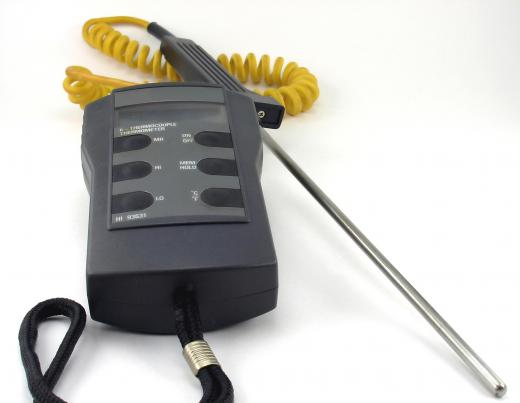What Is a Pyrometer?
The word pyrometer comes from the Greek words pyros, meaning “fire,” and meter meaning “to measure.” A pyrometer is a device that determines a surface temperature by measuring radiant heat. It is generally used in situations where the surface to be measured cannot be touched, either because it is moving or because it would be hazardous to do so. Common varieties include the infrared pyrometer and the optical pyrometer.
The first pyrometer was invented by Josiah Wedgewood, an 18th century English potter. It used the shrinkage of porcelain under heat to monitor approximate temperatures within the Wedgewood kilns. The firing of pottery and monitoring temperature within kilns remains one of the primary applications of pyrometrics today. Modern kilns generally use infrared pyrometers, also known as radiation pyrometers, to monitor their temperature.

Infrared pyrometers use the infrared and visible light radiating off an object to heat a thermocouple, a device that creates an electrical current that powers a temperature gauge. The focal distance — the point where the tool has the minimum spot reading size, and field-of-view — the angle at which the pyrometer’s optics operate, are very important in operating an infrared pyrometer correctly. The device determines an average temperature for the region it is measuring, so if the object being measured does not fill the pyrometer’s field of vision, a measuring error will occur.
Precise measurements also require a correct judgment of a surface’s emissivity. The infrared light coming from a surface is actually the sum of three factors: reflectivity — the proportion of the radiation coming from elsewhere and reflected off the surface being measured; transmissivity — the proportion of radiation coming from behind the object being measured and passing through it; emissivity — the proportion of the infrared radiation actually being emitted from the measured surface. These three values range between zero and one, and together they total one. Infrared pyrometers work best if emissivity is close to one, and they are very difficult to calibrate for reflective metals and transparent surfaces with emissivities of 0.2 or lower.
The other variety in common use is an optical pyrometer. First patented by Everett F. Morse in 1899, the optical pyrometer runs a current through a filament that is connected to a temperature gauge. An operator looks through an eyepiece at the filament and at the surface being measured. As the current through the filament varies, so does the temperature of the filament. When the filament’s incandescence matches the surface’s incandescence, the temperature can be read off the gauge. In most applications, optical pyrometers have been replaced by infrared pyrometers, which offer more precision over a broader temperature range, but optical pyrometers remain in use, particularly when measuring temperatures of relatively hot and small objects, such as annealing tungsten wires.
AS FEATURED ON:
AS FEATURED ON:











Discuss this Article
Post your comments